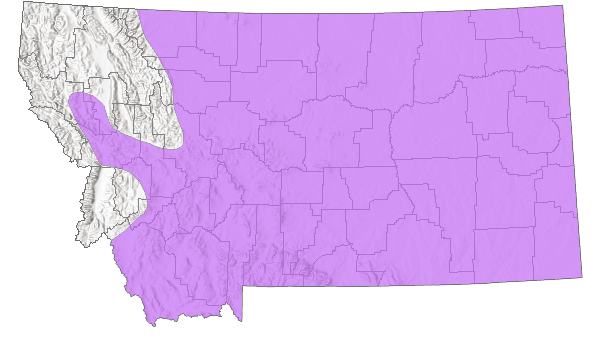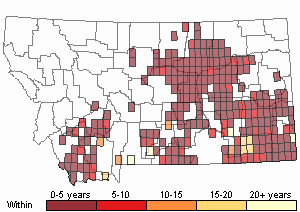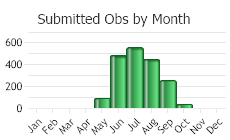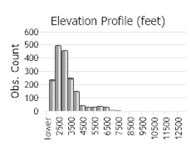View in other NatureServe Network Field Guides
NatureServe
Montana
Utah
Wyoming
Idaho
Wisconsin
British Columbia
South Carolina
Yukon
California
New York
Wyoming Big Sagebrush - Artemisia tridentata ssp. wyomingensis
General Description
We do not yet have descriptive information on this species. Please try the buttons above to search for information from other sources.
Diagnostic Characteristics
Subspecies wyomingensis is usually less than 50 cm tall with a roundedc crown; its leaves are usually less than 15 mm long and are shortly tapered towards the petiole.
Species Range
Montana Range
Range Descriptions

 Native
Native
Range Comments
WA to MT (barely also into the western parts of the Dakotas and NE), south to CA, AZ and NM (Kartesz 2009).
Observations in Montana Natural Heritage Program Database
Number of Observations: 2175
(Click on the following maps and charts to see full sized version)
Map Help and Descriptions
Relative Density

Recency



 (Observations spanning multiple months or years are excluded from time charts)
(Observations spanning multiple months or years are excluded from time charts)
Stewardship Responsibility
References
- Additional ReferencesLegend:
 View Online Publication
View Online Publication
Do you know of a citation we're missing? Bilbao, J.V. 2008. Predicting feeding site selection of mule deer on foothill and mountain rangelands. M.Sc. Thesis. Bozeman, MT: Montana State University. 40 p.
Bilbao, J.V. 2008. Predicting feeding site selection of mule deer on foothill and mountain rangelands. M.Sc. Thesis. Bozeman, MT: Montana State University. 40 p. Bray, R.O. 1990. The influence of selected Artemisia compounds on mule deer preference. M.Sc. Thesis. Bozeman MT: Montana State University. 68 p.
Bray, R.O. 1990. The influence of selected Artemisia compounds on mule deer preference. M.Sc. Thesis. Bozeman MT: Montana State University. 68 p. Harvey, S.J. 1981. Life history and reproductive stategies in Artemisia. M.Sc. Thesis. Bozeman, MT: Montana State University. 132 p.
Harvey, S.J. 1981. Life history and reproductive stategies in Artemisia. M.Sc. Thesis. Bozeman, MT: Montana State University. 132 p. Harvey, S.J. 1990. Responses of steppe plants to gradients of water soil texture and disturbance in Montana, U.S.A. Ph.D. Thesis. Bozeman, MT: Montana State University. 34 p.
Harvey, S.J. 1990. Responses of steppe plants to gradients of water soil texture and disturbance in Montana, U.S.A. Ph.D. Thesis. Bozeman, MT: Montana State University. 34 p. Hoffman, T.L. 1996. An ecological investigation of mountain big sagebrush in the Gardiner Basin. M.Sc. Thesis. Bozeman, MT: Montana State University. 84 p.
Hoffman, T.L. 1996. An ecological investigation of mountain big sagebrush in the Gardiner Basin. M.Sc. Thesis. Bozeman, MT: Montana State University. 84 p. Johnson, C.M. 2002. Effects of black-tailed prairie dogs on the mixed-grass prairie in Montana. M.Sc. Thesis. Bozeman, MT: Montana State University. 89 p.
Johnson, C.M. 2002. Effects of black-tailed prairie dogs on the mixed-grass prairie in Montana. M.Sc. Thesis. Bozeman, MT: Montana State University. 89 p. Johnson, J.D. 2004. Restoring native species to crested wheatgrass dominated rangelands. M.Sc.Thesis. Bozeman, MT: Montana State University. 58 p.
Johnson, J.D. 2004. Restoring native species to crested wheatgrass dominated rangelands. M.Sc.Thesis. Bozeman, MT: Montana State University. 58 p. Kitchen, K.A. 2010. The influence of Douglas-fir and Rocky Mountain juniper on Wyoming and mountain big sagebrush cover in southwest Montana. M.Sc. Thesis. Bozeman, MT: Montana State University. 87 p.
Kitchen, K.A. 2010. The influence of Douglas-fir and Rocky Mountain juniper on Wyoming and mountain big sagebrush cover in southwest Montana. M.Sc. Thesis. Bozeman, MT: Montana State University. 87 p. Lesica, P., M.T. Lavin, and P.F. Stickney. 2012. Manual of Montana Vascular Plants. Fort Worth, TX: BRIT Press. viii + 771 p.
Lesica, P., M.T. Lavin, and P.F. Stickney. 2012. Manual of Montana Vascular Plants. Fort Worth, TX: BRIT Press. viii + 771 p. Lesica, P., M.T. Lavin, and P.F. Stickney. 2022. Manual of Montana Vascular Plants, Second Edition. Fort Worth, TX: BRIT Press. viii + 779 p.
Lesica, P., M.T. Lavin, and P.F. Stickney. 2022. Manual of Montana Vascular Plants, Second Edition. Fort Worth, TX: BRIT Press. viii + 779 p. McColley, S.D. 2007. Restoring aspen riparian stands with beaver on the northern Yellowstone winter range. M.Sc. Thesis. Bozeman, MT: Montana State University. 67 p.
McColley, S.D. 2007. Restoring aspen riparian stands with beaver on the northern Yellowstone winter range. M.Sc. Thesis. Bozeman, MT: Montana State University. 67 p. Mehus, C.A. 1995. Influences of browsing and fire on sagebrush taxa of the northern Yellowstone winter range. M.Sc. Thesis. Bozeman, MT: Montana State University. 70 p.
Mehus, C.A. 1995. Influences of browsing and fire on sagebrush taxa of the northern Yellowstone winter range. M.Sc. Thesis. Bozeman, MT: Montana State University. 70 p. Mendelsohn, B.J. 2010. Factors influencing big sagebrush cover in southwest Montana. M.Sc. Thesis. Bozeman, MT: Montana State University. 75 p.
Mendelsohn, B.J. 2010. Factors influencing big sagebrush cover in southwest Montana. M.Sc. Thesis. Bozeman, MT: Montana State University. 75 p. Pallister, G.L. 1974. The seasonal distribution and range use of bighorn sheep in the Beartooth Mountains, with special reference to the West Rosebud and Stillwater herds. M.Sc. Thesis. Bozeman, MT: Montana State University. 67 p.
Pallister, G.L. 1974. The seasonal distribution and range use of bighorn sheep in the Beartooth Mountains, with special reference to the West Rosebud and Stillwater herds. M.Sc. Thesis. Bozeman, MT: Montana State University. 67 p. Personius, T.L. 1985. The influence of crude terpenoid constituents on mule deer preference for big sagebrush and black sagebrush. M.Sc. Thesis. Bozeman, MT: Montana State University. 46 p.
Personius, T.L. 1985. The influence of crude terpenoid constituents on mule deer preference for big sagebrush and black sagebrush. M.Sc. Thesis. Bozeman, MT: Montana State University. 46 p. Quire, R.L. 2013. The sagebrush steppe of Montana and southeastern Idaho shows evidence of high native plant diversity, stability, and resistance to the detrimental effects of nonnative plant species. M.Sc. Thesis. Bozeman, MT: Montana State University. 124 p.
Quire, R.L. 2013. The sagebrush steppe of Montana and southeastern Idaho shows evidence of high native plant diversity, stability, and resistance to the detrimental effects of nonnative plant species. M.Sc. Thesis. Bozeman, MT: Montana State University. 124 p. Roy, J.L. 1992. Ecology of reintroduced Rocky Mountain bighorn sheep following two transplants in the southern Madison Range, Montana. M.SC. Thesis. Bozeman, MT: Montana State University. 102 p.
Roy, J.L. 1992. Ecology of reintroduced Rocky Mountain bighorn sheep following two transplants in the southern Madison Range, Montana. M.SC. Thesis. Bozeman, MT: Montana State University. 102 p. Seipel, T.F. 2006. Plant species diversity in the sagebrush steppe of Montana. M.Sc. Thesis. Bozeman, MT: Montana State University. 87 p.
Seipel, T.F. 2006. Plant species diversity in the sagebrush steppe of Montana. M.Sc. Thesis. Bozeman, MT: Montana State University. 87 p. Striby, Karl D. 1985. The in vitro digestibility and utilization of Big Sagebrush and Black Sagebrush. M.Sc. Thesis. Bozeman, MT: Montana State University. 111 p.
Striby, Karl D. 1985. The in vitro digestibility and utilization of Big Sagebrush and Black Sagebrush. M.Sc. Thesis. Bozeman, MT: Montana State University. 111 p. Taylor, K., T. Brummer, L.J. Rew, B.D. Maxwell. 2014. Bromus tectorum response to fire varies with climate conditions. Ecosystems 17(6): 960-973. http://dx.doi.org/10.1007/s10021-014-9771-7
Taylor, K., T. Brummer, L.J. Rew, B.D. Maxwell. 2014. Bromus tectorum response to fire varies with climate conditions. Ecosystems 17(6): 960-973. http://dx.doi.org/10.1007/s10021-014-9771-7 Thompson, Scott K. 2002. Browse condition and trend on Montana ungulate ranges. M.Sc. Thesis. Bozeman, MT: Montana State University. 147 p.
Thompson, Scott K. 2002. Browse condition and trend on Montana ungulate ranges. M.Sc. Thesis. Bozeman, MT: Montana State University. 147 p. Tyers, D.B. 2003. Winter ecology of moose on the Northern Yellowstone Winter Range. Ph.D. Dissertation. Bozeman, MT: Montana State University. 308 p.
Tyers, D.B. 2003. Winter ecology of moose on the Northern Yellowstone Winter Range. Ph.D. Dissertation. Bozeman, MT: Montana State University. 308 p. Walhof, K. S. 1997. A comparison of burned and unburned big sagebrush communities in southwest Montana. M.Sc. Thesis. Bozeman, MT: Montana State University. 74 p.
Walhof, K. S. 1997. A comparison of burned and unburned big sagebrush communities in southwest Montana. M.Sc. Thesis. Bozeman, MT: Montana State University. 74 p. Williams, K.L. 2012. Classification of the grasslands, shrublands, woodlands, forests and alpine vegetation associations of the Custer National Forest portion of the Beartooth Mountains in southcentral Montana. M.Sc. Thesis. Bozeman, MT: Montana State University. 376 p.
Williams, K.L. 2012. Classification of the grasslands, shrublands, woodlands, forests and alpine vegetation associations of the Custer National Forest portion of the Beartooth Mountains in southcentral Montana. M.Sc. Thesis. Bozeman, MT: Montana State University. 376 p.
- Web Search Engines for Articles on "Wyoming Big Sagebrush"





